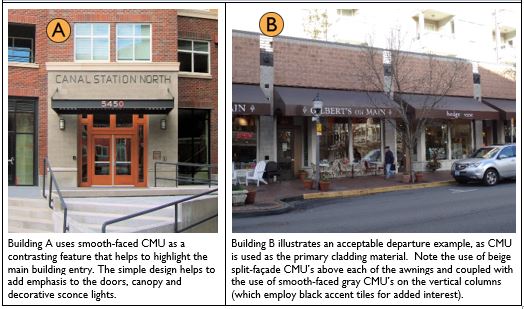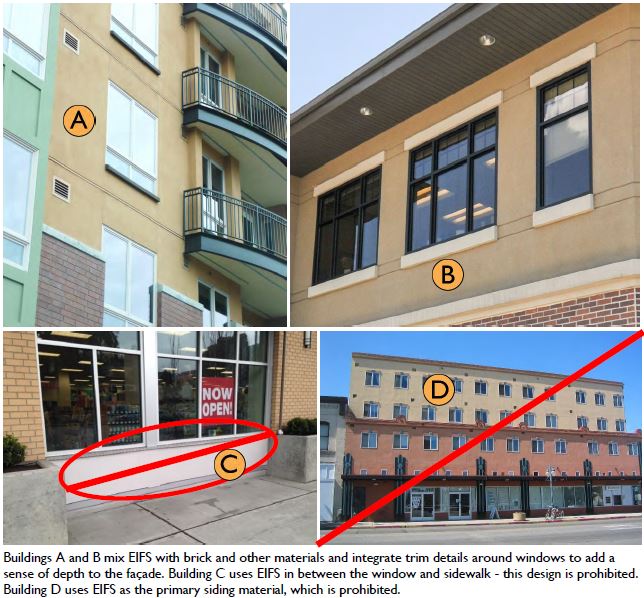12.48.530 Building materials.
A. Purpose.
1. To encourage the use of durable, high quality, and urban building materials that minimize maintenance cost and provide visual interest from all observable vantage points.
2. To promote the use of a distinctive mix of materials that helps to articulate façades and lends a sense of depth and richness to the buildings.
3. To place the highest priority on the first floor in the quality and detailing of materials at the pedestrian scale.
B. Special Conditions and Limitations for the Use of Certain Cladding Materials.
1. Concrete block (also known as concrete masonry unit or CMU) may be used as a secondary cladding material (no more than one-third of total façade cladding) on all building façades and other building elevations facing parks, publicly accessible outdoor spaces, and containing primary building entrances provided it is incorporated with other permitted materials.
Departures will be considered for alternative designs that use concrete block as the primary, but not the only, cladding material provided the design incorporates a combination of textures and/or colors to add visual interest. For example, combining split or rock-façade units with smooth blocks can create distinctive patterns. The figures below illustrate acceptable concrete block use/designs.
Fig. 12.48.530.B.1. Acceptable concrete block use/design.

2. Metal siding may be used on all street-facing building elevations provided it complies with the following regulations:
a. It must feature visible corner molding and trim. Masonry, concrete, or other durable material must be incorporated between the metal siding and the ground plane for all residential buildings and storefronts.
b. Metal siding must be factory finished, with a matte, nonreflective surface.
Departures will be considered provided the material’s integration and overall façade composition meets the purpose of the regulations.
Fig. 12.48.530.B.2. Acceptable metal siding examples.

3. Regulations for the Use of Exterior Insulation and Finish System (EIFS). Such material/finishes may be used when it complies with the following:
a. EIFS is limited to no more than 20 percent of the total façade area and may not be the primary cladding material on nonresidential and mixed-use buildings.
b. EIFS must feature a smooth or sand finish only.
c. EIFS must be trimmed in wood, masonry, or other material and must be sheltered from weather by roof overhangs or other methods.
d. EIFS must not be used on the ground floor of façades containing nonresidential uses.
Departures will be considered provided the material’s integration and overall façade composition meet the purpose of the regulations.
Fig. 12.48.530.B.3. Acceptable and unacceptable EIFS examples.

4. Cementitious wall board paneling/siding may be used provided it meets the following provisions:
a. Cement board paneling/siding may not be used on ground-level façades containing nonresidential uses.
b. Where cement board paneling/siding is the dominant siding material, the design must integrate a mix of colors and/or textures that are articulated consistent with windows, balconies, and modulated building surfaces and are balanced with façade details that add visual interest from the ground-level and adjacent buildings.
Departures will be considered provided the material’s integration and overall façade composition meets the purpose of the regulations.
Fig. 12.48.530.B.4. Acceptable and unacceptable cementitious wall board examples.

(Ord. 2341 § 5 (Exh. A), 2020).